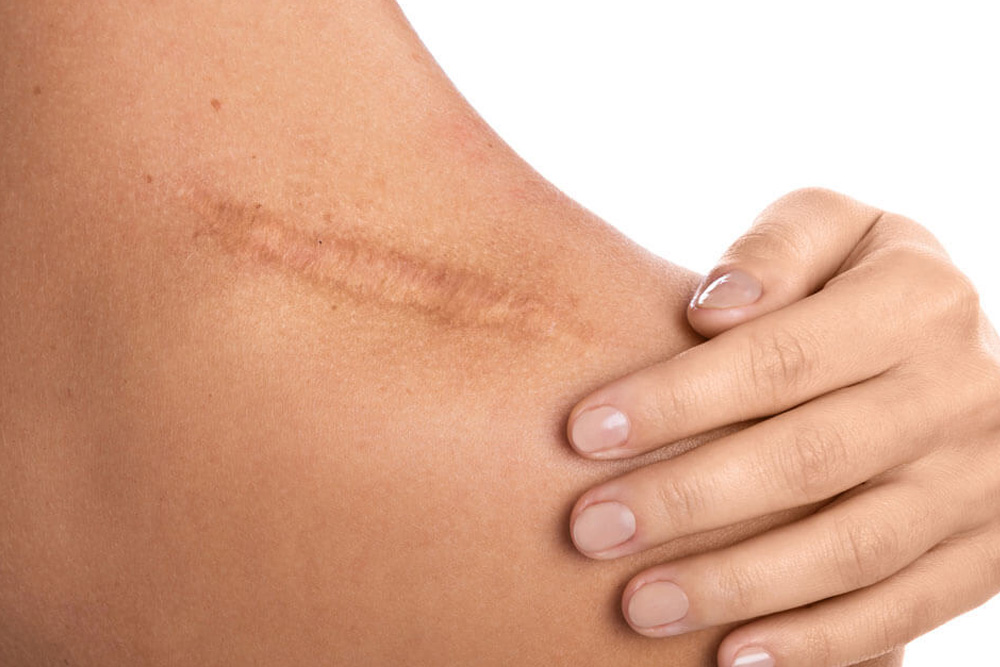Scar Treatment
What to Know About
Scar Treatment
Scar Treatment covers a variety of procedures that help minimize the visible appearance of scars. When your body experiences an injury, either through a traumatic event, severe acne, burn, or a medical procedure, scar tissue forms as part of the healing process. While some scars are small and not easily noticed, others can be large, disfiguring, or a cause of emotional distress. Some scars can also affect muscular functions, particularly on the face. If you have one or more scars that you’d like to minimize, Scar Treatment may offer the solution you need.

How Does Scar Treatment Work?
Scars can form in many shapes, depths, sizes, and levels of severity. To give you the most satisfactory and successful result, your dermatologist will evaluate your scar(s) to determine the best course of action. Some common options for Scar Treatments include:
- Surgery: This procedure involves the total or partial removal of the scar. Though surgery leaves its own scars, your dermatologist will alter the affected area to release tension or restore function. They will then carefully close the wound to create a smaller, less noticeable scar.
- Dermabrasion: Using a special brush, your dermatologist will remove the scar’s top layers of skin. When new skin tissue grows over the treated area, it creates softer skin and minimizes irregularities.
- Laser therapy: This treatment uses FDA-approved laser technology to apply energy to your scar tissue. As your tissue absorbs the energy, it encourages the growth of new collagen and softens the scar’s surface. Your body’s natural healing processes can then improve your scar’s appearance.
- Genius™ Microneedling Treatments: Genius treatments use microneedling with radiofrequency (RF) energy to reduce the appearance of scars, improve skin texture, and correct minor skin sagging, with minimal pain and downtime after treatment.
- Additional, more intensive procedures include skin grafting, surgical removal of large areas of scar tissue, and tissue expansion.
Conditions It Treats
As mentioned above, scar treatment procedures can be used to treat a variety of scars. Different types of treatable scars include:
- Keloids: When scar tissue grows past the edges of the original wound, it is known as a keloid scar. They often develop in areas with little fatty tissue, such as the chest, neck, shoulders, ears, and face. These are typically larger and may pucker, itch, or cause pain.
- Hypertrophic: These scars form right at the wound site as clusters of scar tissue. Hypertrophic scars may be raised, uncomfortable, and/or red. They may also be light in color (hypo-pigmented) or darker in color (hyperpigmented).
- Contractures: During the healing process, some scars pull the skin and underlying tissue too tight, restricting movement. Contractures can also form around joint wounds and over injuries that cause significant tissue loss.
Who Should Get Scar Treatment?
Each case is unique, so you’ll want to discuss the options for your scar(s) with your dermatologist.
What to Expect from Your Scar Treatment Appointment
First, your dermatologist will need to examine and evaluate your scar. At this appointment, they will discuss available treatments and help you choose the best option for your needs. Most Scar Revision procedures require either local anesthesia or sedation, so it’s important to follow your doctor’s instructions leading up to your treatment.
Scar Treatment aftercare is essential to minimize any scarring caused by the procedure. Your dermatologist will likely recommend that you keep the treated area elevated after your procedure. You should also follow all instructions for wound care, nutrition, and activity restrictions for the best results.
